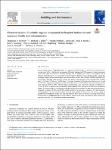Characterisation of volatile organic compounds in hospital indoor air and exposure health risk determination
| dc.contributor.author | Riveron, Thiphanie | |
| dc.contributor.author | Wilde, Michael | |
| dc.contributor.author | Ibrahim, W | |
| dc.contributor.author | Carr, L | |
| dc.contributor.author | Monks, PS | |
| dc.contributor.author | Greening, NJ | |
| dc.contributor.author | Gaillard, Erol | |
| dc.contributor.author | Brightling, CE | |
| dc.contributor.author | Siddiqui, S | |
| dc.contributor.author | Hansell, Anna | |
| dc.contributor.author | Cordell, Rebecca Lynne | |
| dc.date.accessioned | 2023-11-27T18:05:09Z | |
| dc.date.available | 2023-11-27T18:05:09Z | |
| dc.date.issued | 2023-08 | |
| dc.identifier.issn | 0360-1323 | |
| dc.identifier.issn | 1873-684X | |
| dc.identifier.other | 110513 | |
| dc.identifier.uri | https://pearl.plymouth.ac.uk/handle/10026.1/21712 | |
| dc.description.abstract |
Several volatile organic compounds (VOCs) have impacts on human health, but little is known about the concentrations of VOCs in the hospital environment. This study characterised VOCs present in clinical assessment rooms. More than 600 samples of air were collected over 31 months (2017–2020) at two hospital sites in Leicester, United Kingdom, and analysed by comprehensive two-dimensional gas chromatography, making this the largest hospital environment database worldwide on VOCs and first such UK study. The most abundant VOCs found were 2-propanol, ethyl chloride, acetone and hexane, with respective mean concentrations of 696.6 μgm−3, 436.5 μgm−3, 83.9 μgm−3 and 58.5 μgm−3. Acetone, 2-propanol and hexane concentrations were 4, 9 and 30-fold higher respectively compared to similar studies performed in other hospitals. Our results showed that the most frequently detected VOCs, with the highest concentrations, were most likely released by healthcare activities, or related to ingress of vehicle emissions. Hazard quotient (HQ) and cancer risk (CR) were calculated to identify the potential risk of VOCs exposure to the health of healthcare workers. No HQs were measured above 1, compared to inhaled US EPA and OEHHA health guidelines for non-cancer chemicals. For both hospitals, trichloroethylene CR were calculated above 1E-06 by using inhaled US EPA cancer risk values, leading to possible risks to healthcare workers with long-term exposure. More studies of this type, including measurements of VOCs such as formaldehyde that we were unable to include in this study, are needed to better characterise exposures and risks, both to healthcare workers and patients. | |
| dc.format.extent | 110513-110513 | |
| dc.language | en | |
| dc.publisher | Elsevier BV | |
| dc.subject | Volatile organic compounds | |
| dc.subject | Hospital environment | |
| dc.subject | Hazard quotient | |
| dc.subject | Cancer risk | |
| dc.subject | Healthcare workers | |
| dc.title | Characterisation of volatile organic compounds in hospital indoor air and exposure health risk determination | |
| dc.type | Journal Article | |
| plymouth.author-url | https://www.webofscience.com/api/gateway?GWVersion=2&SrcApp=PARTNER_APP&SrcAuth=LinksAMR&KeyUT=WOS:001037037400001&DestLinkType=FullRecord&DestApp=ALL_WOS&UsrCustomerID=11bb513d99f797142bcfeffcc58ea008 | |
| plymouth.volume | 242 | |
| plymouth.publication-status | Published | |
| plymouth.journal | Building and Environment | |
| dc.identifier.doi | 10.1016/j.buildenv.2023.110513 | |
| plymouth.organisational-group | |Plymouth | |
| plymouth.organisational-group | |Plymouth|Faculty of Science and Engineering | |
| plymouth.organisational-group | |Plymouth|Faculty of Science and Engineering|School of Geography, Earth and Environmental Sciences | |
| plymouth.organisational-group | |Plymouth|REF 2021 Researchers by UoA | |
| plymouth.organisational-group | |Plymouth|Users by role | |
| plymouth.organisational-group | |Plymouth|Users by role|Academics | |
| plymouth.organisational-group | |Plymouth|REF 2021 Researchers by UoA|UoA07 Earth Systems and Environmental Sciences | |
| plymouth.organisational-group | |Plymouth|REF 2028 Researchers by UoA | |
| plymouth.organisational-group | |Plymouth|REF 2028 Researchers by UoA|UoA07 Earth Systems and Environmental Sciences | |
| dc.date.updated | 2023-11-27T18:04:42Z | |
| dc.rights.embargodate | 2023-11-29 | |
| dc.identifier.eissn | 1873-684X | |
| rioxxterms.versionofrecord | 10.1016/j.buildenv.2023.110513 |


